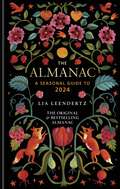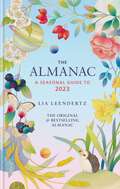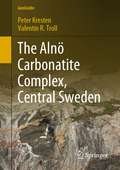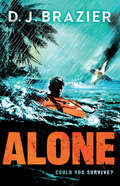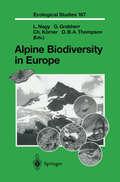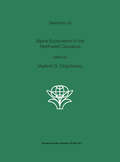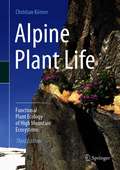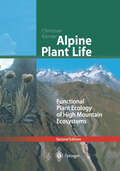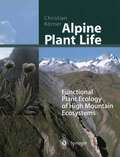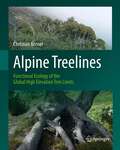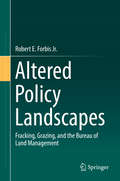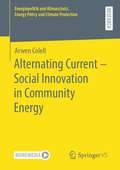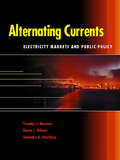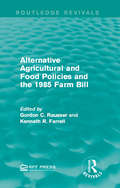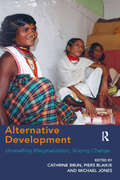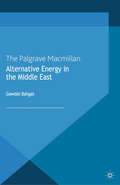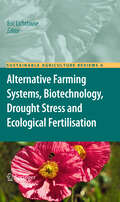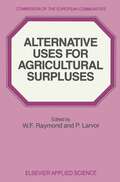- Table View
- List View
The Almanac: A Seasonal Guide To 2018 (Almanac)
by Lia LeendertzTHE ORIGINAL & BESTSELLING ALMANACReconnect with the seasons in Britain and Ireland with this month-by-month guide to the world around us - including tide tables, sunrises and moon phases; garden feasts, wildlife and folklore; seasonal recipes, snacks and more.The Almanac: A Seasonal Guide to 2024 gives you the tools and inspiration you need to celebrate, mark and appreciate each month of the year in your own particular way.Divided into the 12 months, a set of tables each month gives it the feel and weight of a traditional almanac, providing practical information that gives access to the outdoors and the seasons, perfect for expeditions, meteor-spotting nights and beach holidays. This year's edition focuses on the natural wonders of the garden, celebrating the beautiful flora and fauna at your doorstep. There are also features on each month's unique nature, plus a flower and a snack of the month.You will find yourself referring to The Almanac all year long, revisiting it again and again, and looking forward to the next edition as the year draws to a close.PRAISE FOR THE ALMANAC:'Lia Leendertz's classic almanac never fails to delight' - The Herald'It's a perfect Christmas present' - Allan Jenkins, The Observer'The perfect companion to the seasons' - India Knight'Indispensable' - Sir Bob Geldof'This book is your bible' - The Independent'I love this gem of a book' - Cerys Matthews
The Almanac: THE SUNDAY TIMES BESTSELLER (Almanac)
by Lia LeendertzTHE ORIGINAL & SUNDAY TIMES BESTSELLING ALMANAC Reconnect with the seasons in Britain and Ireland with this month-by-month guide to the world around us - including key dates, tide tables and garden tasks; constellations and moon phases; sunrises, folk songs, seasonal recipes plus a 'bun of the month'; and - because 2023 will be a good year for planet spotting - the solar system and the zodiac.The Almanac: A Seasonal Guide to 2023 gives you the tools and inspiration you need to celebrate, mark and appreciate each month of the year in your own particular way. Divided into the 12 months, a set of tables each month gives it the feel and weight of a traditional almanac, providing practical information that gives access to the outdoors and the seasons, perfect for expeditions, meteor-spotting nights and beach holidays. There are also features on each month's unique nature, with this instalment following the swirling micro world of the garden pond through the year.You will find yourself referring to The Almanac all year long, revisiting it again and again, and looking forward to the next edition as the year draws to a close.This year's edition is illustrated by artist Whooli Chen.The geographical scope of The Almanac is Britain and IrelandPRAISE FOR THE ALMANAC:'Lia Leendertz's classic almanac never fails to delight' - The Herald'It's a perfect Christmas present' - Allan Jenkins, The Observer'The perfect companion to the seasons' - India Knight'Indispensable' - Sir Bob Geldof'This book is your bible' - The Independent'I love this gem of a book' - Cerys Matthews
The Alnö Carbonatite Complex, Central Sweden (GeoGuide)
by Valentin R. Troll Peter KrestenThis GeoGuide provides an overview of the geology of Alnö, combined with an up-to-date field itinerary. Covering all major geological aspects, it offers an essential summary of Alnö and its intriguing magmatic rocks in a compact form suitable for field excursions and home study alike. As one of the type localities for carbonatite, the late Proterozoic Alnö ring complex has been a crucial site for carbonatite-related research (next to the Fen complex in Norway), and provided one of the earliest test beds for this unique group of igneous rocks. Five geological excursions introduce the visitor to the most rewarding outcrops, including detailed descriptions and a wealth of high-quality colour photographs. The excursions are complemented by a detailed review of the history of scientific investigation on Alnö and, in particular, a catalogue of exotic and common minerals associated with the complex’s carbonatitic and alkaline silicate rocks. Finally, a summary of its trace element and isotope geochemistry as well as a brief outlook on Alnö’s potential as a future source of Rare Earth Elements (REEs) completes the book.
Alone
by D J BrazierThe trip of a lifetime - that’s what it was supposed to be, paid for with money Gran left thirteen-year old Sam in her will, but when the small plane taking Sam and his Dad back to the airport crashes in the jungle, Sam is left alone and terrified.As time passes with no sign of rescue, Sam grows weaker and has to dig deep to find levels of resolve and resourcefulness he never knew he had in order to survive.Desperate and close to giving up, Sam’s spirits are lifted by the arrival of an otter cub whose companionship and loyalty give Sam the strength he needs to keep going. But when disaster strikes, Sam has to make the hardest decision of his life. Can Sam save his friend and make it out of the jungle alive?
Alone on the Wall: Alex Honnold and the Ultimate Limits of Adventure
by David Roberts Alex Honnold‘Riveting . . . Honnold is neither crazy nor reckless. Alone on the Wall reveals him to be an utterly unique and extremely appealing young man’ Jon Krakauer, bestselling author of Into the Wild Alex Honnold is one of the world's best ‘free solo’ climbers, he scales impossible rock faces without ropes, pitons or and support of any kind. Exhilarating, brilliant and dangerous, there is a purity to Alex's climbs that is easy to comprehend, but also impossible to fathom; in the last forty years, only a handful of climbers have pushed themselves as far, ‘free soloing’ to the absolute limit of human capabilities. Half of them are dead. From Yosemite's famous Half Dome to the frighteningly difficult El Sendero Luminoso in Mexico, Alone on the Wall explores Alex's seven most extraordinary climbing achievements so far. These are tales to make your palms sweat and your feet curl with vertigo. Together, they get to the heart of how – and why – Alex does what he does. Exciting, uplifting and truly awe-inspiring, Alone on the Wall is a book about the essential truth of being free to pursue your passions and the ability to maintain a singular focus, even in the face of mortal danger.Alex is the subject of the BAFTA winning and Oscar nominated film Free Solo.
Alpine Biodiversity in Europe (Ecological Studies #167)
by Laszlo Nagy Georg Grabherr Christian Körner Desmond B. A. ThompsonThe United Nations Conference on the Environment and Development (UNCED), held in Rio de Janeiro in 1992, spawned a multitude of pro grammes aimed at assessing, managing and conserving the earth's biological diversity. One important issue addressed at the conference was the mountain environment. A specific feature of high mountains is the so-called alpine zone, i. e. the treeless regions at the uppermost reaches. Though covering only a very small proportion of the land surface, the alpine zone contains a rela tively large number of plants, animals, fungi and microbes which are specifi cally adapted to cold environments. This zone contributes fundamentally to the planet's biodiversity and provides many resources for mountain dwelling as well as lowland people. However, rapid and largely man-made changes are affecting mountain ecosystems, such as soil erosion, losses of habitat and genetic diversity, and climate change, all of which have to be addressed. As stated in the European Community Biodiversity Strategy, "the global scale of biodiversity reduction or losses and the interdependence of different species and ecosystems across national borders demands concerted international action". Managing biodiversity in a rational and sustainable way needs basic knowledge on its qualitative and quantitative aspects at local, regional and global scales. This is particularly true for mountains, which are distributed throughout the world and are indeed hot spots of biodiversity in absolute terms as well as relative to the surrounding lowlands.
Alpine Ecosystems in the Northwest Caucasus (Geobotany #29)
by Vladimir G. OnipchenkoPlant geographical description of the area, syntaxonomy, spatial patterns, floristic richness, structure of plant communities in relation to soil properties and herbivore influence were described for a mountain region that is difficult to access. Seasonal, inter-annual, and long-term dynamics of vegetation are discussed on the base of long-term observations as well as pollen and phytolith analyses. Population biology of alpine plants is studied by combination of field observations and mathematical modelling. Plant population strategies and soil seed banks are described for alpine plants from several communities. Results of long-term ecological experiments (plant reciprocal transplantations, dominant removals, light limitation) showed the significance of competition and facilitation for community organization. Structure of soil algal and fungal communities is represented as well as mycorrhiza of alpine plants. Main animal groups (wild) history and modern nature conservation problems are discussed.
Alpine Plant Life: Functional Plant Ecology of High Mountain Ecosystems
by Christian KörnerThis book is a completely revised, substantially extended treatment of the physical and biological factors that drive life in high mountains. The book covers the characteristics of alpine plant life, alpine climate and soils, life under snow, stress tolerance, treeline ecology, plant water, carbon, and nutrient relations, plant growth and productivity, developmental processes, and two largely novel chapters on alpine plant reproduction and global change biology. The book explains why the topography driven exposure of plants to dramatic micro-climatic gradients over very short distances causes alpine biodiversity to be particularly robust against climatic change. Geographically, this book draws on examples from all parts of the world, including the tropics. This book is complemented with novel evidence and insight that emerged over the last 17 years of alpine plant research. The number of figures – mostly in color – nearly doubled, with many photographs providing a vivid impression of alpine plant life worldwide.Christian Körner was born in 1949 in Austria, received his academic education at the University of Innsbruck, and was full professor of Botany at the University of Basel from 1989 to 2014. As emeritus Professor he is continuing alpine plant research in the Swiss Alps.
Alpine Plant Life: Functional Plant Ecology of High Mountain Ecosystems
by Christian KörnerGenerations of plant scientists have been fascinated by alpine plant life - with the exposure of organisms to dramatic climatic gradients over a very short distance. This comprehensive text treats a wide range of topics: alpine climate and soils, plant distribution and the treeline phenomenon, physiological ecology of water-, nutritional- and carbon relations of alpine plants, plant stress and plant development, biomass production, and aspects of human impacts on alpine vegetation. Geographically the book covers all parts of the world including the tropics.This second edition of Alpine Plant Life gives new references, new diagrams, and extensively revised chapters.
Alpine Plant Life: Functional Plant Ecology of High Mountain Ecosystems
by Christian KörnerGenerations of plant scientists have been fascinated by alpine plant lifean ecosystem that experiences dramatic climatic gradients over a very short distance. This comprehensive book examines a wide range of topics including alpine climate and soils, plant distribution and the treeline phenomenon, plant stress and development, global change at high elevation, and the human impact on alpine vegetation. Geographically, the book covers all parts of the world including the tropics.
Alpine Treelines: Functional Ecology of the Global High Elevation Tree Limits
by Christian KörnerAlpine treelines mark the low-temperature limit of tree growth and occur in mountains world-wide. Presenting a companion to his book Alpine Plant Life, Christian Körner provides a global synthesis of the treeline phenomenon from sub-arctic to equatorial latitudes and a functional explanation based on the biology of trees. The comprehensive text approaches the subject in a multi-disciplinary way by exploring forest patterns at the edge of tree life, tree morphology, anatomy, climatology and, based on this, modelling treeline position, describing reproduction and population processes, development, phenology, evolutionary aspects, as well as summarizing evidence on the physiology of carbon, water and nutrient relations, and stress physiology. It closes with an account on treelines in the past (palaeo-ecology) and a section on global change effects on treelines, now and in the future. With more than 100 illustrations, many of them in colour, the book shows alpine treelines from around the globe and offers a wealth of scientific information in the form of diagrams and tables.
Alps Mountain Biking: From Aosta to Zermatt: The Best Singletrack, Enduro and Downhill Trails in the Alps
by Steve MallettAlps Mountain Biking is a guide to the western Alps. It reveals epic rocky descents, high-altitude blasts and hidden Alpine singletrack, all set against a backdrop of snowy peaks, pine forests and clear blue skies. This is some of the greatest singletrack, enduro and downhill riding the mountains have to offer. Featuring the Alpine hot spots alongside the best lesser-known areas, you can ride the main lines of Morzine and Chamonix, and then escape the crowds and head to La Plagne, Martigny or Sauze d'Oulx. Using lifts, buses and good old pedal power, you can really exploit the massive vertical gains each area has to offer and enjoy trails that cater for every taste and ability. Alps Mountain Biking has everything you need to get out of the concrete resorts and plan a great riding trip. Written by Samoëns-based guide Steve Mallett, it gives you the local riders' inside knowledge on trails, and information on accommodation, lifts and travel. Packed with fantastic photography, it is guaranteed to inspire you to get out and explore this huge mountain bike playground.
Altered Policy Landscapes: Fracking, Grazing, and the Bureau of Land Management
by Robert E. Forbis Jr.This book documents the United States Bureau of Land Management's (BLM) shift from a rancher-dominated agency to an energy-dominated agency. This shift is analyzed by identifying the conditions under which the expansion of hydraulic fracturing (fracking) in the Rocky Mountain West triggered a political conflict between ranching and energy stakeholder groups. Through scrutiny of federal actions and policies implemented by the Executive Branch between 2004 and 2010, the book sheds light on the emphasis of domestic energy production during this time period, and how the traditional ranching and energy alliance was split by shifting policy interests. The book is meant for policy makers, natural resource agencies, and students and researchers engaged in political science, public administration, and natural resource management. Chapter 1 introduces readers to the case study at hand, and reviews literature on public land agencies and policies. Chapter 2 summarizes the legal history of public land management by the federal government, and the conditions that caused the BLM to favor energy development over ranching in the mid-2000's. Chapter 3 details the role of the Executive Branch (Bush-Cheney administration) in affecting the BLM's domestic energy policies and resource allocation, and chapter 4 analyzes the role of subgovernments in affecting the BLM's motivations too. Chapters 5, 6 and 7 contain first-hand accounts from government officials, state petroleum associations, and ranching supported interest groups to explore the concept of subgovernment stakeholder domination in policymaking, and analyze the similarities and differences between different policy-making elites. Chapter 8 concludes the text by summarizing subgovernment theory, mapping the behaviors of subgovernment actors, and discussing the implications for future political appointees in the direction of land-management agencies like the BLM.
Alternating Current – Social Innovation in Community Energy (Energiepolitik und Klimaschutz. Energy Policy and Climate Protection)
by Arwen ColellCommunity energy projects give their own answers to the challenges of energy system change: They are social innovations. By building new relations between local economies, communities and technical infrastructures, these projects not only change the energy system but also respective power structures. Drawing on case studies from Germany, Denmark and Scotland, this book shows the importance of community ties, and shared symbols for successful processes of transformation and develops recommendations for policy decision-makers.
Alternating Currents: Electricity Markets and Public Policy
by Timothy J. Brennan Karen L. Palmer Salvador A. MartinezMany states within the U.S., and many countries across the world, are opening their electicity markets to competition. Many others are uncertain about their plans. These differences emphasize the complexities involved in the technology and regulatory structure of the electricity industry--an industry for which the introduction of market competition has been notoriously difficult. In response to these challenges, Alternating Currents provides a timely overview and analysis of the concerns facing industry regulators, legislators, and others as they consider whether, when, and how to open electricity markets. Authors Brennan, Palmer, and Martinez offer background on the history of regulatory policy and the technology for producing and delivering electric power. They then provide insights into the policy debates and economic issues involved in eleven important topics, including industry structure, system integrity and reliability, the mitigation of market power, and environmental protection. Alternating Currents describes the recent events leading to the demise of retail competition in California with the intent on drawing lessons for the future. In the end, the authors offer their perspective about what makes electricity a unique resource and how those factors make the potential conflict between competition and reliability the most pressing of the long-term concerns about the transformation of the electric power industry.
Alternating Currents: Electricity Markets and Public Policy
by Timothy J. Brennan Karen L. Palmer Salvador A. MartinezMany states within the U.S., and many countries across the world, are opening their electicity markets to competition. Many others are uncertain about their plans. These differences emphasize the complexities involved in the technology and regulatory structure of the electricity industry--an industry for which the introduction of market competition has been notoriously difficult. In response to these challenges, Alternating Currents provides a timely overview and analysis of the concerns facing industry regulators, legislators, and others as they consider whether, when, and how to open electricity markets. Authors Brennan, Palmer, and Martinez offer background on the history of regulatory policy and the technology for producing and delivering electric power. They then provide insights into the policy debates and economic issues involved in eleven important topics, including industry structure, system integrity and reliability, the mitigation of market power, and environmental protection. Alternating Currents describes the recent events leading to the demise of retail competition in California with the intent on drawing lessons for the future. In the end, the authors offer their perspective about what makes electricity a unique resource and how those factors make the potential conflict between competition and reliability the most pressing of the long-term concerns about the transformation of the electric power industry.
Alternative Agricultural and Food Policies and the 1985 Farm Bill (Routledge Revivals)
by Gordon C. Rausser Kenneth R. FarrellIn 1985, the U.S. Congress confronted the difficult and complex task of developing a 5-year omnibus legislation allowing for lower commodity prices. But, policies predicated on the concept of agriculture as a unique sector of the economy became less and less appropriate to the highly interdependent, open agricultural economy throughout the 1980s. First published in 1985, this collection of 16 papers and related discussions contained in these proceedings is an important contribution toward understanding the issues, options, and dilemmas in U.S. agricultural policy. This is an ideal title for students interested in environmental studies, agriculture, and national policy.
Alternative Agricultural and Food Policies and the 1985 Farm Bill (Routledge Revivals)
by Gordon C. Rausser Kenneth R. FarrellIn 1985, the U.S. Congress confronted the difficult and complex task of developing a 5-year omnibus legislation allowing for lower commodity prices. But, policies predicated on the concept of agriculture as a unique sector of the economy became less and less appropriate to the highly interdependent, open agricultural economy throughout the 1980s. First published in 1985, this collection of 16 papers and related discussions contained in these proceedings is an important contribution toward understanding the issues, options, and dilemmas in U.S. agricultural policy. This is an ideal title for students interested in environmental studies, agriculture, and national policy.
Alternative Arrangements for Marine Fisheries: An Overview (Routledge Revivals)
by Francis T. Christy, Jr.The maintenance of the freedom of fishing in the face of the changing circumstances that were occurring at the time of this title’s original publication in 1973 had produced several damaging consequences. It had led to considerable waste, in both biological and economic terms, and had been the source of increasing conflict. This waste can only be prevented by the adoption of management measures and by the removal of the condition of free and open access. This book explores various techniques for this, and will be of interest to students of environmental management.
Alternative Arrangements for Marine Fisheries: An Overview (Routledge Revivals)
by Francis T. Christy, Jr.The maintenance of the freedom of fishing in the face of the changing circumstances that were occurring at the time of this title’s original publication in 1973 had produced several damaging consequences. It had led to considerable waste, in both biological and economic terms, and had been the source of increasing conflict. This waste can only be prevented by the adoption of management measures and by the removal of the condition of free and open access. This book explores various techniques for this, and will be of interest to students of environmental management.
Alternative Development: Unravelling Marginalization, Voicing Change
by Cathrine Brun Piers BlaikieThis book brings together a collection of essays that discuss alternative development and its relevance for local/global processes of marginalization and change in the Global South. Alternative development questions who the producers of development knowledges and practices are, and aims at decentring development and geographical knowledge from the Anglo-American centre and the Global North. It involves resistance to dominant political-economic processes in order to further the possibilities for non-exploitative and just forms of development. By discussing how to unravel marginalization and voice change through alternative methods, actors and concepts, the book provides useful guidance on understanding the relationship between theory and practice. The main strength of the book is that it calls for a central role for alternative development in the current development discourse, most notably related to justice, rights, globalization, forced migration, conflict and climate change. The book provides new ways of engaging with alternative development thinking and making development alternatives relevant.
Alternative Development: Unravelling Marginalization, Voicing Change
by Cathrine Brun Piers BlaikieThis book brings together a collection of essays that discuss alternative development and its relevance for local/global processes of marginalization and change in the Global South. Alternative development questions who the producers of development knowledges and practices are, and aims at decentring development and geographical knowledge from the Anglo-American centre and the Global North. It involves resistance to dominant political-economic processes in order to further the possibilities for non-exploitative and just forms of development. By discussing how to unravel marginalization and voice change through alternative methods, actors and concepts, the book provides useful guidance on understanding the relationship between theory and practice. The main strength of the book is that it calls for a central role for alternative development in the current development discourse, most notably related to justice, rights, globalization, forced migration, conflict and climate change. The book provides new ways of engaging with alternative development thinking and making development alternatives relevant.
Alternative Energy in the Middle East (Energy, Climate and the Environment)
by G. BahgatThe Middle East region holds the world's largest oil and natural gas proven reserves. Several Middle Eastern States are major oil producers and consumers. Given price fluctuations and environmental concerns many countries have sought to diversify their energy mix. The Middle East is no exception. Gawdat Bahgat analyzes the geopolitical, economic and strategic forces behind this diversification in the Middle East. He highlights the main advantages and disadvantages of each source of energy.
Alternative Farming Systems, Biotechnology, Drought Stress and Ecological Fertilisation (Sustainable Agriculture Reviews #6)
by Eric LichtfouseSustainable agriculture is a rapidly growing field aiming at producing food and energy in a sustainable way for our children. This discipline addresses current issues such as climate change, increasing food and fuel prices, starvation, obesity, water pollution, soil erosion, fertility loss, pest control and biodiversity depletion. Novel solutions are proposed based on integrated knowledge from agronomy, soil science, molecular biology, chemistry, toxicology, ecology, economy, philosophy and social sciences. As actual society issues are now intertwined, sustainable agriculture will bring solutions to build a safer world. This book series analyzes current agricultural issues, and proposes alternative solutions, consequently helping all scientists, decision-makers, professors, farmers and politicians wishing to build safe agriculture, energy and food systems for future generations.
